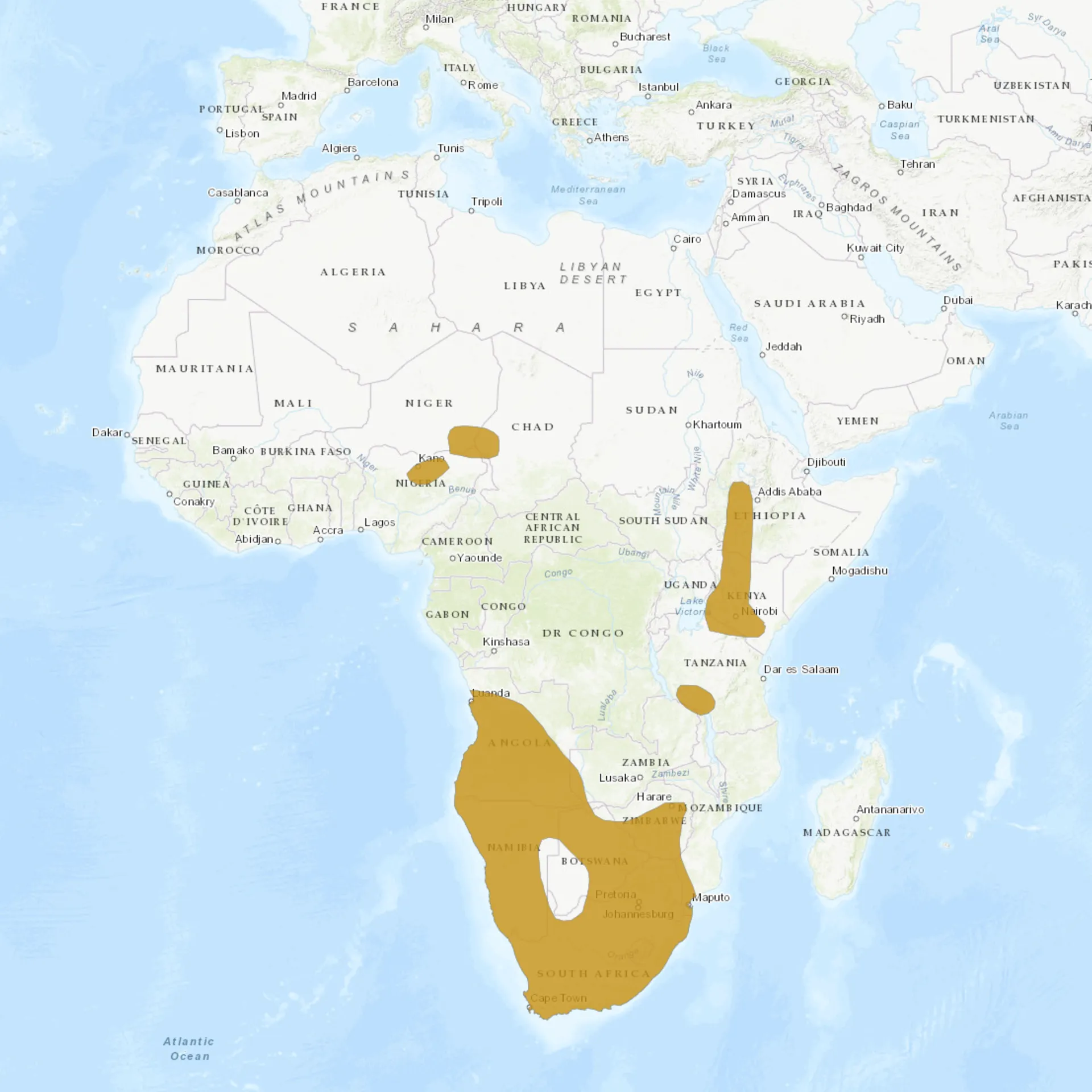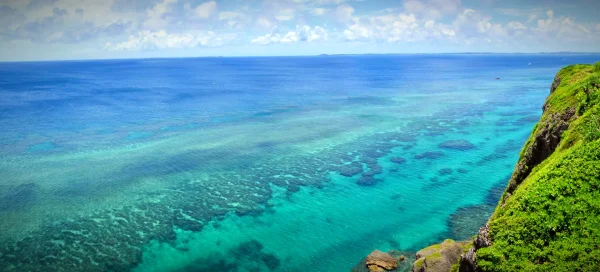Overview
The Cape teal (Anas capensis) is a medium-sized dabbling duck native to Africa. It is known for its distinctive pale gray plumage and striking pinkish-red bill. Unlike many other teal species, it lacks a noticeable sexual dimorphism, meaning males and females look nearly identical. This highly adaptable species can be found in both freshwater and brackish wetlands, including lakes, marshes, and estuaries. Cape teals are primarily non-migratory, though they may undertake local movements in response to water availability.
They are often seen foraging in shallow water, using a combination of dabbling and filter-feeding techniques to extract small invertebrates and plant matter. Their pinkish-red bill is specially adapted for straining food from the water, making them highly efficient feeders. Cape teals are typically quiet birds but may produce soft whistles and quacks, particularly during courtship and territorial displays. They are social outside the breeding season, often forming flocks with other waterfowl species.
Cape teals are well adapted to arid and semi-arid environments, using seasonal wetlands that form after rainfall. Their ability to tolerate saline water allows them to inhabit coastal lagoons and salt pans where few other ducks can thrive. Depending on rainfall patterns, they breed opportunistically and typically nest near water, constructing simple ground nests hidden among vegetation. Despite facing habitat degradation in some areas, their population remains stable, and they are classified as a species of Least Concern by the IUCN.
Taxonomy
Kingdom
Phylum
Class
Order
Family
Genus
Species
Type
Current distribution:
Cape teals are widely distributed across sub-Saharan Africa, with populations found in South Africa, Namibia, Botswana, Zimbabwe, Mozambique, and as far north as Sudan and Ethiopia. They are most common in the southern and eastern parts of the continent, particularly in regions with seasonal wetlands. Unlike migratory waterfowl, they are mostly sedentary, though they may move locally in search of suitable feeding and breeding sites. Their ability to use freshwater and brackish habitats allows them to persist in diverse environments.
Although their numbers fluctuate based on rainfall and wetland availability, their overall population remains stable. They are often found in protected areas such as national parks and wetlands designated Ramsar sites. Habitat loss due to wetland drainage and agricultural expansion is a growing concern, but they have shown resilience by adapting to artificial water bodies. Conservation efforts focus on wetland preservation and sustainable water management to ensure the long-term survival of their populations.
Physical Description:
Cape teals are medium-sized ducks with slender bodies, long necks, and rounded heads, giving them a graceful appearance. Their plumage is predominantly pale gray with fine, dark speckling on the head and body, providing excellent camouflage in wetland environments. The most distinctive feature is their pinkish-red bill, contrasting sharply with their otherwise muted coloration. Their eyes are a deep red, adding to their unique and striking appearance.
They have long, pointed wings that allow for agile flight, and their legs are positioned towards the center of their body, making them proficient swimmers. Their underwings display a greenish speculum bordered with white, visible in flight. Males and females are similar in size and coloration, with only minor differences in bill shape and overall body proportions. Juveniles resemble adults but have duller plumage and a less vibrant bill color.

Lifespan: Wild: ~10 Years || Captivity: ~20 Years

Weight: Male: 14–18 oz (400–500 g) || Female: 12–17 oz (350–480 g)

Length: Male: 17–19 in (43–48 cm) || Female: 16–18 in (41–46 cm)

Height: Male: 14–16 in (36–41 cm) || Female: 13–15 in (33–38 cm)

Top Speed: 45 mph (72 km/h)
Characteristic:
Native Habitat:
Cape teals primarily inhabit freshwater and brackish wetlands, including lakes, rivers, marshes, and temporary floodplains. They are well adapted to arid and semi-arid regions, where they exploit seasonal water bodies that form after rainfall. Their ability to tolerate saline conditions allows them to thrive in coastal lagoons, estuaries, and salt pans, where few other waterfowl species can survive. They prefer open water with abundant aquatic vegetation, which provides food and cover.
They typically nest on the ground near water, selecting sites hidden among reeds or grasses to protect their eggs from predators. Unlike other duck species, they do not require large bodies of water and can breed in small, isolated wetlands. During periods of drought, Cape teals may move to more permanent water sources, but they do not undertake long-distance migrations. Their adaptability to different wetland habitats has contributed to their widespread distribution across Africa.
Biomes:
Biogeographical Realms:
Continents:
Diet:
Diet & Feeding Habits:
Cape teals are omnivorous dabbling ducks, feeding on a mix of plant material and small invertebrates. Their diet includes aquatic vegetation, seeds, algae, crustaceans, and insect larvae, which they filter from the water using specialized lamellae in their bill. They primarily forage in shallow water, often tipping forward in a dabbling motion to access food below the surface. During dry seasons, they may rely more on seeds and plant material found along the edges of wetlands.
These ducks are most active at dawn and dusk when they feed in small groups or mixed flocks with other waterfowl. Their ability to tolerate saline water allows them to exploit food sources in coastal habitats where freshwater species struggle to survive. They may also scavenge on agricultural fields after flooding, feeding on spilled grains and small aquatic organisms. In captivity, their diet is supplemented with grains, greens, and small protein sources to mimic their natural feeding habits.
Mating Behavior:
Mating Description:
Cape teals form monogamous pairs during the breeding season, with both parents participating in raising the young. Breeding is highly dependent on rainfall and wetland availability, occurring year-round in some regions but peaking during the rainy season. Females construct simple ground nests lined with grass and down feathers, often hidden among reeds or other vegetation. Clutches typically contain 6–10 eggs, which the female incubates while the male remains nearby to defend the nest.
After hatching, the ducklings are precocial and can swim and feed themselves within hours. Both parents protect the brood, guiding them to safe feeding areas. The young fledge within 50–60 days but may stay with their parents longer before becoming fully independent. Cape teals reach sexual maturity at about one year old and establish their own breeding territories.
Reproduction Season:
Birth Type:
Pregnancy Duration:
Female Name:
Male Name:
Baby Name:
Social Structure Description:
Cape Teals exhibit highly social behavior, often found in large flocks outside the breeding season. These gatherings provide safety in numbers, reducing predation risk and increasing the foraging efficiency. Within these flocks, a complex social hierarchy governs interactions among individuals. The social structure facilitates information sharing, such as the location of feeding grounds and potential threats.
During the breeding season, however, Cape Teals become more territorial, with pairs establishing and defending nesting sites. This shift in social dynamics underscores the species’ adaptability to different ecological requirements throughout the year. Forming cohesive groups is beneficial for migration, allowing Cape Teals to travel vast distances to exploit seasonal wetlands. Understanding the social structure of Cape Teals is essential for conservation efforts, as it influences their habitat use, breeding success, and survival strategies.
Groups:
Conservation Status:
Population Trend:
Cape Teals are considered to have a stable population trend across their range, with no immediate threats leading to a significant decline. Their adaptability to various wetland habitats has contributed to their resilience against habitat loss in some areas. Conservation areas and national parks are vital in providing these ducks with safe breeding and foraging grounds.
Efforts to conserve wetland ecosystems are crucial for maintaining healthy populations of Cape Teals. These habitats support a diversity of life and are essential for many waterfowl species’ breeding success and survival. Preserving these environments ensures that Cape Teals continue to thrive, contributing to aquatic ecosystems’ ecological balance and biodiversity.
Population Threats:
The primary threats to Cape Teals are habitat destruction and degradation due to agricultural expansion, urbanization, and climate change. Wetland drainage for agriculture reduces available feeding and breeding sites, directly impacting their population. Pollution and water contamination from industrial activities pose additional risks, affecting these ducks’ health and food sources.
Conservation initiatives focused on wetland protection and restoration are vital for mitigating these threats. Legal protections, such as designating protected areas and enforcing regulations on wetland use, can help preserve crucial habitats. Public awareness and education about the importance of wetlands for biodiversity and climate regulation are also essential in promoting conservation efforts and reducing human impact on these critical ecosystems.
Conservation Efforts:
Conservation efforts for the Cape Teal and its habitat include establishing protected areas and implementing wetland restoration projects. International agreements, such as the Ramsar Convention, have significantly promoted wetland conservation globally. These initiatives aim to preserve the ecological character of wetlands, ensuring that waterfowl and other aquatic species have suitable habitats for feeding, breeding, and migration.
Community involvement and sustainable land-use practices are also critical components of conservation strategies. Engaging local communities in conservation efforts creates a greater opportunity for sustainable management of wetland resources. Research and monitoring programs are essential for understanding the impacts of environmental changes on Cape Teal populations and guiding conservation actions. These efforts collectively contribute to the long-term survival of the Cape Teal and the preservation of wetland biodiversity.
Additional Resources:
Fun Facts
- Cape Teals can extract salt from brackish water, allowing them to inhabit saline environments.
- They are one of the few duck species that can be found in both freshwater and saline wetlands.
- Cape Teals have a unique pinkish bill, making them easily identifiable among other duck species.
- They are capable of long-distance migrations, demonstrating remarkable endurance.
- The species plays a significant role in controlling aquatic invertebrate populations.
- Cape Teals’ feathers are highly waterproof, aiding their buoyancy and insulation.
- They exhibit a high level of parental care, with both parents involved in raising the young.
- Cape Teals can adapt their diet using available resources, showcasing their flexibility.
- Conservation areas and protected wetlands are crucial for their breeding success and survival.
- The Cape Teal’s vocalizations are crucial for communication within flocks and during courtship, though not as varied as those of some species.




















































































